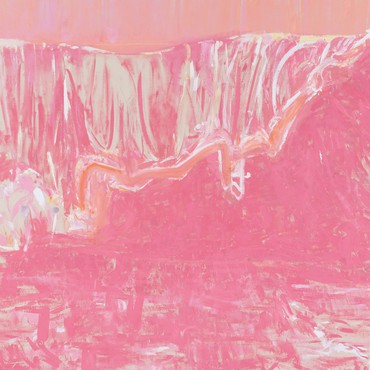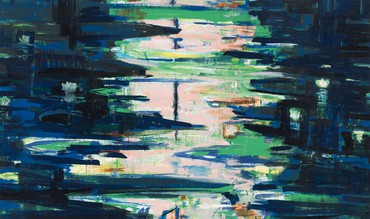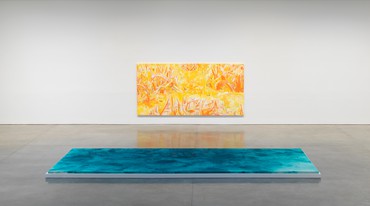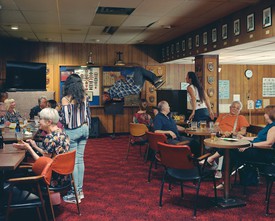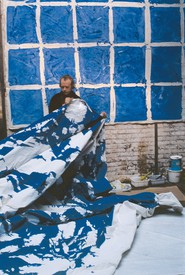
Tiana Reid is an assistant professor in the Department of English at York University, Toronto. Her writing has been published in Aperture, Art in America, Artforum, Canadian Art, Frieze, the Nation, the New York Review of Books, the Paris Review, Vulture, and elsewhere.
In the neighborhood I moved into recently, real estate developers keep putting up signs demarcating their investment. This is the same neighborhood that my grandmother immigrated to from Jamaica in the 1970s, the same neighborhood where my parents first met in the 1980s, and the same neighborhood where I grew up in the 1990s.
Several of the infrastructure company’s warning signs read “danger due to demolition.” But all over the fenced enclosure, “demolition” has been crossed out and replaced by words including “profiteering,” “speculation,” “lack of housing,” and “capitalism.” In the midst of all that rewriting, an advertising poster for the future building has a tattooed white man modeling in a white T-shirt and khaki pants. Over that someone has written, “diversity via fake working-class trousers.” I laugh, realizing I’m wearing my brown Carhartt jacket on the way to my office, and then I look down to change the song on my headphones and I keep walking.
It is all rather cute and rather funny, maybe even worthy of an Instagram story or two, but then, a few days later, the sidewalks don’t get shoveled in front of the demolition site. I’m walking to the subway after an ice storm and the developers still haven’t salted their sidewalk either, and while I’m slipping and sliding, it is clear that the joke is in fact on me. Uh oh, property—a sick joke, mocking basic needs for housing as if it were some sort of private indulgence.
But before I cross a line, your little boundary, let me take a step back. I hesitate to push too much concept around here, too many narratives. I am here to discuss some new art by Cy Gavin. In Gavin’s telling, the work has him thinking about property lines, pathways, and boundaries. Just before a new exhibition, in conversation, he is often using that saying. He is always “thinking about” something, if my memory has it correctly.
At the same time, as the late critic Peter Schjeldahl wrote in 1993 in a review of a Gerhard Richter show (republished the following year in his book Columns & Catalogues), “Painting is art’s philosophical warehouse, stocked with visceral responses to Western culture’s every big idea.” Painting stores the history of thought itself. Gavin’s richly colored paintings—bringing about illumination, shadows, movement, and lines in constant flux—engage with the idea of painting itself.
What does painting’s tortured availability yield? Gavin constitutes a world that seems to be growing, outlining, shifting, shrinking, changing, soaking, moving, selecting, swallowing, surrendering, allowing, forbidding, deepening, pronouncing, rising, historicizing, filling, contrasting. And so his sublime renderings (of waves, trees, paths, rivers, beaver dams, moons, stars) gesture to property as well as to the postindustrial contraaesthetics of boundaries more generally.
While the art world has an enduring preoccupation with figurative representations, postmodern, poststructuralist art-historical discourse has also embedded abstraction with possibility, transgression, and innovation. In critical discourse there has been some talk about abstraction in Gavin’s work. If this is true, it is perhaps only partly true. In the New Yorker, critic Johanna Fateman uses the phrase “semi-abstract,” writing, “In the past, Gavin has paired his panoramas of wild coasts with figures in mythic scenes drawn from the African diaspora and his personal history, but these semi-abstract expanses of craggy shadow are bereft of protagonists.” In 2021, the writer Hilton Als likewise noted Gavin’s interest in landscape, confessing that “Gavin’s images helped me face the hour that I was living in then. I may spend time with the transcendentalists of yore, but acts of transcendence happen in the now. Gavin’s hour was the hour where I felt filled up, quenched, by his faith in art, which reinspired me to see there is faith in the moment of looking.” He continued, “Not too far from where those early transcendentalists set up camp, I saw what Gavin longs to make one feel: his cosmos of planets and colors that were bigger than you and me, and as big as the mind and eye makes them.”
I too feed off Gavin’s cross-wired sensorium, his historically fed and gravely pretty interpretations of settings too fleshly to be called merely “outside.” He moves across the self, the family, the community, the neighborhood, the city, the country, the earth. Gavin stays small, painting his own corner, yet he somehow still manages to address the concentricity of relation with a brutal honesty that has me baffled.
His newest paintings are unfussy recognitions of the artist’s vicinities in not-so-upstate New York. The geographic, social, and political contexts of his wide-ranging engagements are varied. I also think of Gavin as a color theorist, though that sounds limiting. “I think that my colors can be strident, but I also think you can use strident things with subtlety. That’s what I’m trying to do,” Gavin told Alex Frank, in one of the Studio Museum in Harlem’s “Studio Visit” interviews, published in 2017. “It’s hyperbolic in the way of caricature, which can feel closer to the truth by being an exaggeration.” The effect of moonlight, for example, is conveyed in a rich palette of blues.
Taking in the artist’s latest work in person on a rainy and gray day in Long Island City, I got to see the depth and variety of Gavin’s brushstrokes, suggesting choral echoes, a frisson of impressionistic autonomy. In the middle of December, as the city gets duller, darker, blander, I see something of that hyperbole in what I, at first not knowing the work’s name, started referring to as the “pink painting.” I don’t identify as a pink person but Gavin’s vision is almost aggressive, rising and falling with great violence. Relating to waves and drowning, this is not what in addiction-recovery circles they call a “pink cloud,” not a honeymoon phase. Pink is mired in a long and thorny gendered history; I’ve never seen it used in such a way as to evoke a kind of terror that I can’t quite put my finger on. Spectacular fear, maybe. The uncertainty is exaggerated by Gavin’s decision to leave some of the canvas seemingly bare, leaving the viewer alone to think instinctively about what is beneath, and to inquire about painting in general.
To the contrary, a green piece is tight and dusky, melancholic yet somehow representing an opening. This indirect flare of light is both path-making and path-breaking. The painting offers a new drama of greenness, a pungency one can nearly smell. Gavin’s paintings of trees verge on orgiastic: branches and branches, rings and rings, myths and myths, secrets and shadows—multiples all engrossed in one. That tree there, though, is actually not as old as it looks; it is a young tree, he tells me.
Gavin’s richly colored paintings—bringing about illumination, shadows, movement, and lines in constant flux—engage with the idea of painting itself.
But I cannot stray too far from the earth’s thick sedimentation of history. An example: one of Gavin’s newer 2022 pieces, carving out frantic cuts of yellows and oranges, ostensibly represents “crossroads/meadows.” I say “ostensibly” because his stylized reality is faithful not to whatever gets called fact but to the uneventfulness of danger, the cumulative knots of social surrender. It feels like fire.
No doubt it is part self-will and the dominating transcendence of Gavin’s poetics—yes, I can and will call visual art poetry—that chains me to the unverifiable beauty of literature. A passage in the third volume of Mary Shelley’s well-known novel Frankenstein; or, The Modern Prometheus, of 1818, strikes me as an apt description of the quietly powerful scenes that Gavin forges: “It was eight o’clock when we landed; we walked for a short time on the shore, enjoying the transitory light, and then retired to the inn and contemplated the lovely scene of waters, woods, and mountains, obscured in darkness, yet still displaying their black outlines.” This is the kind of elegiac blackness to which Gavin commits: textural, brief, thoughtful, and able to be seen. Or is it sensed?
Where Gavin lives a symbiotic, intertextual relationship to process, his studio world and life upstate embedding themselves in the artistic outcome, I see the stark lines of American society and politics to which he has drawn my attention. To think of boundaries, material and mental, as complex designations of human and plant life is also to find new ways to relate to the desire to turn inward, to isolate, to be single and to believe so wholly in singularity. On the surface this essay does the work of setting, describing the surroundings, walking about. However, as property lines have made and maintained the capitalist world order, they’ve also reordered our minds. I mean that brutality can feel familiar and soft, full of libidinal/economic structures that stagger individual and collective attachments to property relations and juridical sovereignties.
The task of living, which we can only do day by day or minute by minute, can never be fully sanctioned. How else can I explain it? Let me conclude with a quotation from Ludwig Wittgenstein’s book Philosophical Investigations, which was published in 1953, two years after the German philosopher’s death. “When I talk about language (words, sentences, etc.) I must speak the language of everyday,” Wittgenstein exclaims. “Is this language somehow too coarse and material for what we want to say? Then how is another one to be constructed?—And how strange we should be able to do anything at all with the one we have!”
In a broad sense, I am also thinking here of Wittgenstein’s Tractatus Logico-Philosophicus (1921; translated into English in 1922), and especially of how he posits the limits of language as a “limit of the world.” How to unravel the aesthetic records of those of us who encounter the disappointments of the “limit of the world”? and the word? That is to say, the terms of language circumscribe our imaginaries about the past, present, and future. But “what lies on the other side of the limit,” to quote Wittgenstein again, for Gavin is an artistic practice and a poetic labor that looks at visuality the way a writer might look at language.
Expressed in a different way, it felt more impossible than usual to write this essay, especially at first. Every mad moment rushed back to peacekeep itself, to tame the wonder emanating from Gavin’s project. With every word, I feel the deep well of interiority in Gavin’s stunning, inimitable, and dense landscapes, outer and inner swaying back and forth, then a stumble. The trip is almost like the way, upon being born, the boundary you were used to dissolves, and then there is a universal trauma, all of it, and all of a sudden. All of a sudden: time, tears, blood, the difficulty of now.
Cy Gavin, Gagosian, West 21st Street, New York, February 2–March 18, 2023
Artwork © Cy Gavin, photos: Rob McKeever

